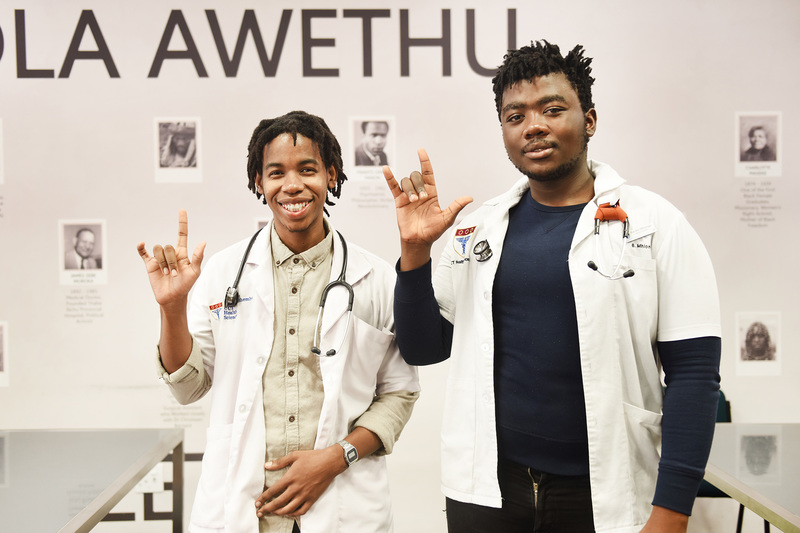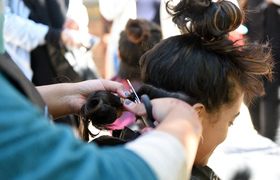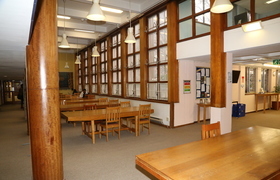A website and app for the Deaf
12 June 2018 | Story Helen Swingler. Photo Robyn Walker. Read time 5 min.
Fourth-year medical students Banele Mhlongo and Vuma Mthembu are developing an app that they are hoping will improve the lives of deaf patients using healthcare facilities – and their understanding of common diseases.
The initiative grew out of a three-month pilot project to introduce South African Sign Language as an extracurricular activity for their third-year counterparts last year. The intention was to better serve the needs and rights of the Deaf, estimated to number around four million in South Africa as far back as 1998.
Students already learn isiXhosa and Afrikaans to better communicate with their patients in the province. But the duo believe that communicating with the Deaf is a vital aspect of the national Health for All campaign. Medical personnel are mostly unable to communicate with Deaf patients to obtain permission to touch them during a medical examination, get a thorough medical history, explain treatment and medication, or to maintain confidentiality.
“The Deaf community has no alternative language other than Sign,” said Mhlongo. “Lip-reading is insufficient. And when examining, about 70% of a diagnosis comes from the patient’s history. To get a good history, you need to ask relevant questions that the patient can understand and respond to.”
“To get a good history, you need to ask relevant questions that the patient can understand and respond to.”
As a result, deaf people often become isolated and shy away from healthcare facilities, where they feel marginalised, as most public health institutions don’t have interpreters. Mhlongo and Mthembu cite the example of a deaf 67-year-old stroke victim who was unable to communicate her symptoms to medical staff. Though she was not misdiagnosed, she felt isolated and often felt unsure of her medical status.
Generally, written communication is not the answer either, as many poorer patients have limited literacy levels and English is not their home language.
“We also all know how poor doctors’ handwriting is!” Mhlongo quipped.
Sign adds value
The sign-language classes are continuing this year to grow interest and awareness, but are not yet part of an already overcrowded formal curriculum. Veteran June Bothma, from the departments of Speech Therapy and Audiology – who is deaf herself – is teaching the students.
Learning sign language will add value to their degree and skills, and give them a competitive edge over medical graduates from other institutions, said Mhlongo and Mthembu. It will also address deafness that results from meningitis, and drug-induced deafness in multidrug-resistant tuberculosis, especially in children.
“Being able to communicate using Sign will allow medical practitioners to stand up for the marginalised, address human rights and offer more inclusive healthcare.”
This extends to the preventative aspect of healthcare. Because many deaf members of the community are marginalised, they miss out on vital information and education, counselling and empowerment programmes about diseases such as HIV/AIDS.
Deaf app needs funders
Mindful of this, Mhlongo and Mthembu have taken their project a step further. They are developing a website and app for the Deaf to explain and communicate about symptoms, treatment and medication for common medical conditions. These include asthma, meningitis, hypertension, HIV/AIDS, TB and diabetes (which has a mortality and morbidity rate higher than for HIV and TB combined).
They are using a sign-language interpreter, a health professional, videos and other visual material to achieve their goals. For example, using Sign and audio, the students have used this platform to explain what asthma is, how it’s treated, the differences between controllers and relievers, some asthma triggers, the importance of avoiding non-steroidal anti-inflammatory drugs, and side effects and how to deal with them.
Instagram is used to target teens, and the duo have added pictures and meme-styled communications to engage this audience. They are now looking for funders and volunteers to support the development of this health education tool.
“We should be caring better for this population, engaging with them and providing better, more equitable, holistic, acceptable and appropriate access to healthcare and information,” Mhlongo added.
But their aim is to pioneer sign-language teaching for all programmes in the medical school, and to get other institutions to adopt it.
 This work is licensed under a Creative Commons Attribution-NoDerivatives 4.0 International License.
This work is licensed under a Creative Commons Attribution-NoDerivatives 4.0 International License.
Please view the republishing articles page for more information.










